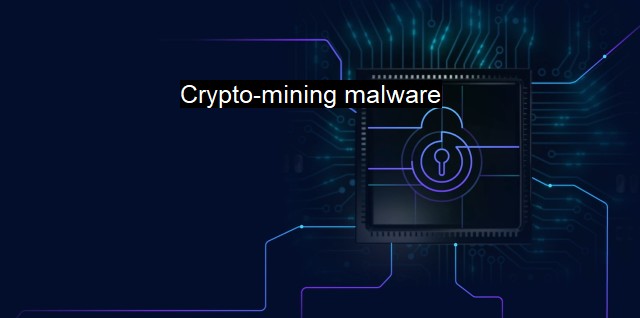What is Crypto-mining malware?
Uncovering the Rising Threat of Crypto-Mining Malware: How Cybercriminals Exploit Cryptocurrencies for Sinister Gains
Crypto-mining malware is a term that has swept across the field of cybersecurity and antivirus in recent years. It is a form of malicious software that cybercriminals use to hijack computer resources to mine cryptocurrency without informed consent. It's called "crypto-mining malware" because the targets are cryptocurrencies such as Bitcoin, Ethereum, and many others.Cryptocurrency mining is a process that involves using various forms of hardware computational power to solve complex mathematical problems. The outcome is the creation of new units of the cryptocurrency, which goes to the miner. Ideally, this is a perfectly lawful activity; when someone uses another person's computational resources to mine cryptocurrencies without consent, it becomes a cybercrime.
The technique behind crypto-mining malware operations is quite crafty. The targets are often unsuspecting users who might unknowingly download the malware hidden within website scripts, downloadable applications, email attachments, or even cloud storage. Often, the malware remains dormant and is hardly noticeable in the early stages, as the cybercriminals do not want you to detect and remove their malware.
Once inside, the crypto-mining malware begins to use portions of the computer’s processing power (CPU or GPU) to run complex computations necessary for cryptocurrency mining. This underhand method does not just consume your hardware resources; it can compromise computer performance leading to heavier CPU usage, slower system operations, system overheating, and premature hardware failure.
Crypto-mining malware poses an emerging threat to cybersecurity as its popularity among cybercriminals is fueled by the potential for high financial gain and the relative anonymity that cryptocurrencies provide. Unlike ransomware that requires the attacker to directly engage the victim for payment, crypto-mining malware can silently generate revenue for as long as it remains undetected.
Antivirus and cybersecurity companies are actively working to provide protection against crypto-mining malware by continuously updating their software to detect the latest versions of these threats. These sophisticated tools scan for known malware signatures in files and active processes. They also employ heuristic analysis to detect new or modified versions of known malware.
Apart from the use of antivirus, individuals and corporations can take measures to lessen the chances of becoming victims. Basic practices like keeping operating systems and software updated, using firewalls, and promoting awareness of phishing and other social engineering attacks can make a significant difference. ad-blocking or anti-cryptomining extensions can be added to web browsers since some crypto-mining malware is delivered through ads or compromised websites.
On corporate networks, it may be helpful to monitor spikes in CPU usage and inspect for devices that seem to have excessive internet traffic, as these can be tell-tale signs of crypto-mining malware’s activity.
Crypto-mining malware marked a new era in cyber-attacks. The innovative nature of these threats calls for continuous, keen-eyed vigilance from the cybersecurity and antivirus companies, plus an active role by individuals and corporations. Behavior-focused analystics, powerful antivirus software, education about potential threats, all combined with regular monitoring of the IT environment, will increase the safeguarding circle from crypto-mining malware and other potential cybersecurity risks. cyber defense needs to move as quickly as the evolution of threats for effective protection against this sneaky, profit-making cyber menace.

Crypto-mining malware FAQs
What is crypto-mining malware?
Crypto-mining malware is a type of malicious software that hijacks a computer's processing power to mine cryptocurrency without the user's knowledge or consent. It can cause the computer to slow down, overheat, or even become permanently damaged.How does crypto-mining malware get onto a computer?
Crypto-mining malware can get onto a computer through various means, such as phishing emails, malicious websites, infected software, and vulnerable servers. It can also be spread through social engineering tactics, such as convincing users to download a seemingly harmless file or click on a fraudulent link.What are the signs that a computer has been infected with crypto-mining malware?
The signs that a computer has been infected with crypto-mining malware include slow performance, excessive heat, increased fan activity, and reduced battery life. Users may also notice unfamiliar processes running in the background, unexplained network activity, and unusual spikes in CPU usage.How can I protect my computer from crypto-mining malware?
To protect your computer from crypto-mining malware, you should keep your software up-to-date, avoid downloading files or clicking on links from unknown or suspicious sources, use strong passwords, and regularly scan your computer for viruses and malware. You can also install browser extensions or ad blockers that block crypto-mining scripts from running on websites.| | A | | | B | | | C | | | D | | | E | | | F | | | G | | | H | | | I | | | J | | | K | | | L | | | M | |
| | N | | | O | | | P | | | Q | | | R | | | S | | | T | | | U | | | V | | | W | | | X | | | Y | | | Z | |
| | 1 | | | 2 | | | 3 | | | 4 | | | 7 | | | 8 | | |||||||